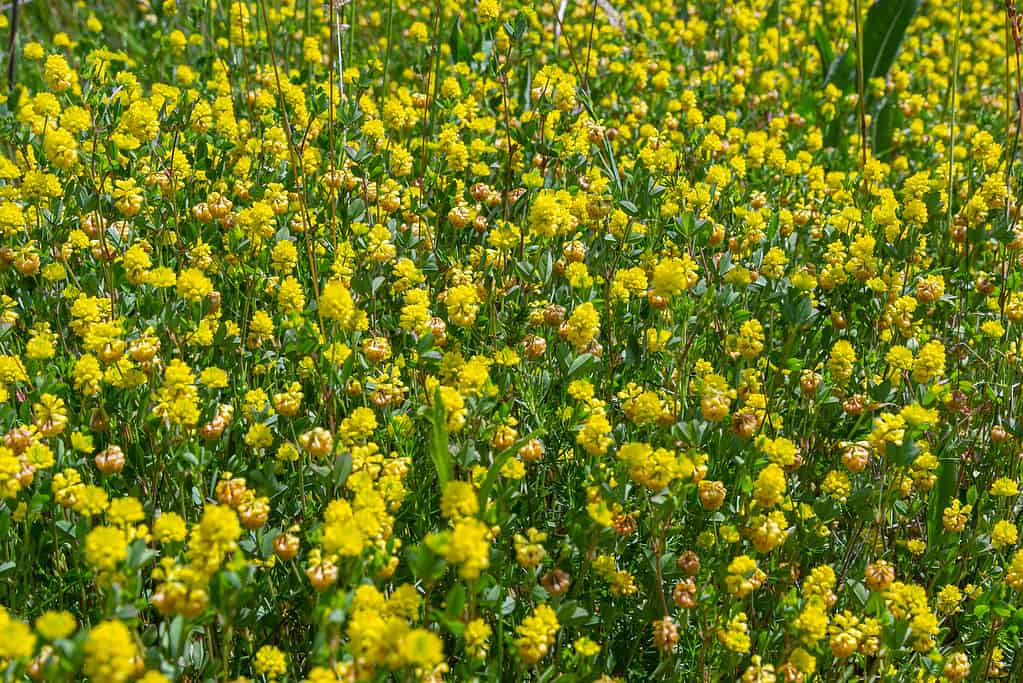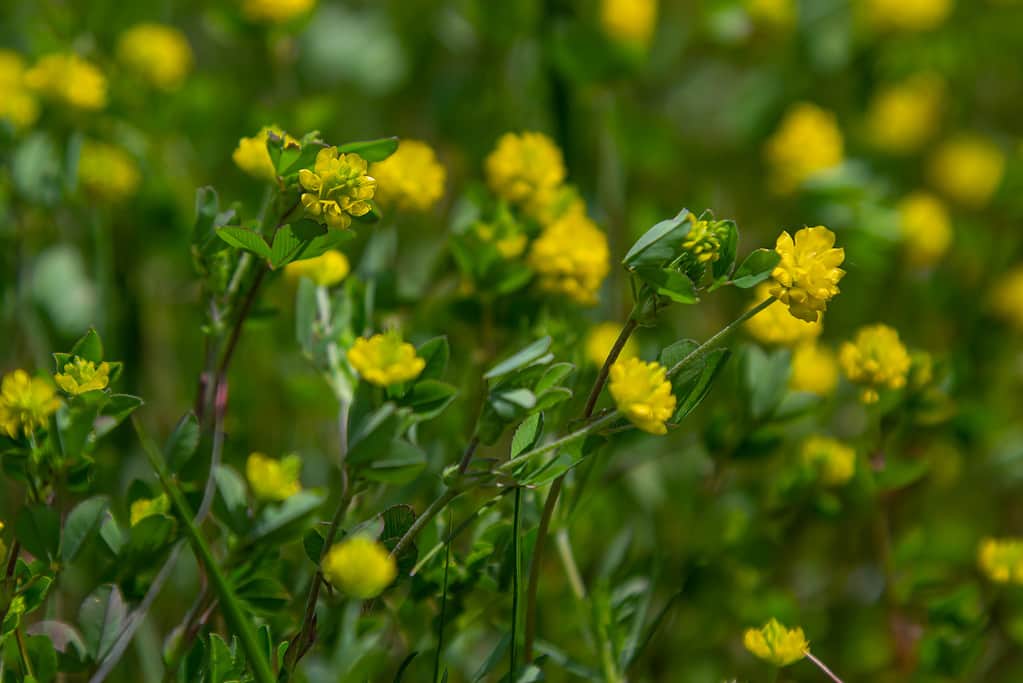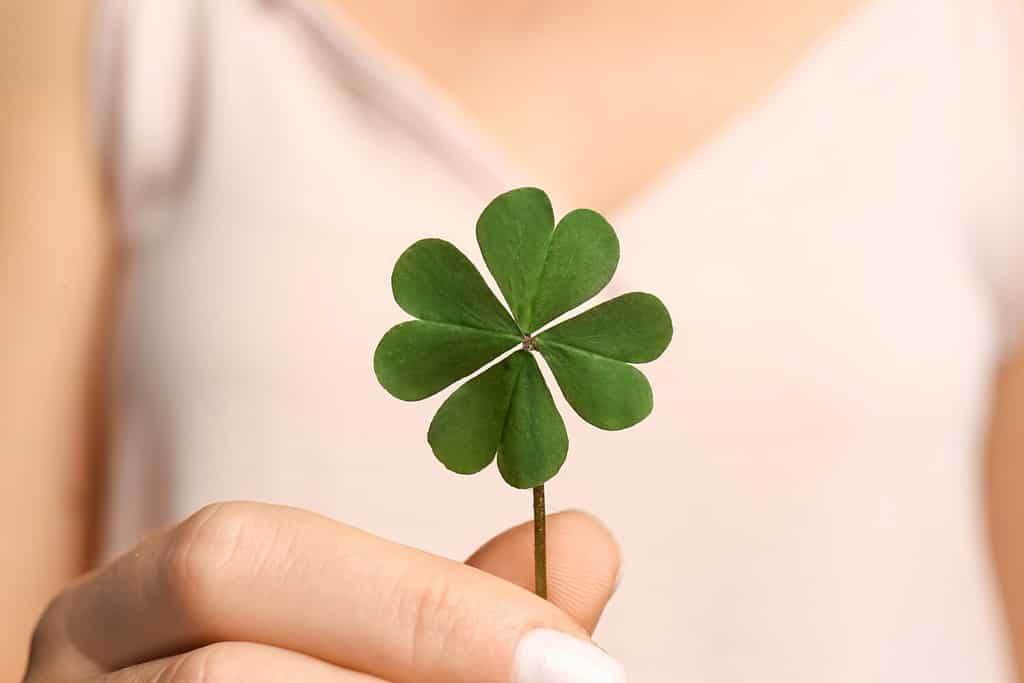The terms shamrock and clover are often used interchangeably. So, many people mistake them for the same plant. And that is understandable. However, there are some differences between the two. We will explore those below to uncover what makes each unique.
| Shamrock | Clover | |
|---|---|---|
| Scientific Classification | Trifolium dubium | Trifolium repens |
| Common Name(s) | Yellow shamrock, lesser hop clover | Clover, purple Dutch clover, white clover |
| Origins | Europe | Europe |
| Size | Shamrocks reach between 4 and 20 inches tall at maturity. | This plant grows to roughly 4 to 6 inches tall. But it can spread up to 12 inches wide or more. |
| Leaves | The green and serrate leaves are less than an inch long and wide. They develop two to three sections per leaf. | The smooth leaves grow in green, gold, or yellow. There are typically three parts per leaf. They are slightly less than 1 inch long and wide. |
| Flowers | These plants require full sun but are tolerant of several soil types. | Shades of gold and copper. They bloom from spring through fall and are less than an inch in diameter. |
| Growing Requirements | These plants require full sun, but are tolerant of several soil types. | Clover requires full sun or partial shade. It requires moist soil. |
| Fun Facts | Shamrocks attract butterflies, bees, and other pollinators. | Clover restores nitrogen to the soil and provides valuable food for livestock. |
Shamrock vs. Clover: Scientific Classification

is often considered the source of the shamrock legend.
©Oleg Marchak/iStock via Getty Images
There is some question as to what the actual shamrock plant is. Several scientific studies have been conducted for more than a century. Based on these findings, the two likely candidates for the true shamrock are Trifolium dubium and Trifolium repens. They both belong to the true clover family. This article will focus on the former.
Clovers, on the other hand, are well-known. They belong to the same genus (Trifolium) and family (Fabaceae). And they are a distinct species within the broader genus, which boasts over 300 species.
Shamrock vs. Clover: Origin
Both plants originated in Europe. However, shamrocks may also come from Macronesia. Each species has taken over to the point that they are ubiquitous throughout Europe and parts of the United States.
Shamrock vs. Clover: Size
Shamrocks are a decent-sized plant. They get up to twenty inches tall at maturity.
However, clovers only grow around four to six inches tall at maturity. Their low profile makes them an ideal ground cover. And what they lack in height, they make up for in width. This sprawling plant can reach up to twelve inches wide (and sometimes more). Its stems happily develop roots as they grow.
Shamrock vs. Clover: Leaves
Trifolium repens have green, serrate leaves that reach less than an inch long and wide. Two to three sections (leaflets) develop per leaf.
But clovers have smooth leaves that grow in several shades. You may spot them in green, gold, or yellow, depending on the time of year. These leaves have three parts that reach slightly less than one inch long and wide. Clover leaves are also edible.
Shamrock vs. Clover: Flowers

Yellow shamrock is aptly named, thanks to its bright and stunning tiny flowers.
©Oleg Marchak/iStock via Getty Images
Yellow shamrocks develop small yellow flowers that show up in late spring and last through fall. The flowers are less than an inch but have four or five petals per flower. Up to fifteen flowers develop on each raceme. These flowers have male and female parts. You will enjoy the copper, gold, and yellow colors of these tiny blossoms.
Clovers develop edible white flowers in the spring. These blossoms are spherical and about 1/2 inch wide. They stick around throughout the summer.
Shamrock vs. Clover: Growing Requirements
Yellow shamrocks are less common than you may think. They are only winter hardy in USDA Hardiness Zones 8 to 9. These picky plants require full sun (make sure they get at least six hours of direct, high-quality light daily). They prefer moist soil but are prone to root rot if the area doesn’t have adequate drainage. However, as long as those needs are met, this plant tolerates several other factors. You can plant it in clay or sand and in areas that receive high foot traffic.
Clover is much more forgiving. It thrives in zones 3 to 10 and can tolerate full sun or partial shade. This plant prefers clay-based or loamy soils kept moist and rich in organic matter. Plant it in a spot that gets plenty of drainage. It’s resistant to rabbits, foot traffic, erosion, and squirrels.
Shamrock vs. Clover: Cultural Significance and Symbolism

Four-leaf clovers are considered a sign of good luck and fortune.
©New Africa/Shutterstock.com
Since shamrocks are technically an unknown plant, their fame lies primarily in their cultural significance and symbolism. Its mythological origin dates back to the 1500s. Debate raged over the ensuing centuries about which plant it actually was. It was associated with Trifolium dubium in 1878 after two English botanists noted that yellow shamrock was sold in Ireland most often around St. Patrick’s Day.
The importance of the shamrock is attributed to Saint Patrick himself. Rumor has it that he used the famous plant to offer a physical representation of the Holy Trinity. However, there is no evidence he did so, making the legend of the shamrock just that – lore. But the shamrock also became embedded in Irish culture, possibly around the same time. The first known writing referencing shamrocks as an accessory happened in 1681. Over the years, it became indelibly connected to the Irish identity.
While many are familiar with shamrocks, nearly everyone has heard of the four-leaf clover. These clovers are extremely rare but do occasionally occur naturally. According to Irish lore, they represent good fortune. Anyone lucky enough to find one is bestowed with love, hope, faith, and luck.
The photo featured at the top of this post is © Rejmann-2/Shutterstock.com
Thank you for reading! Have some feedback for us? Contact the AZ Animals editorial team.







